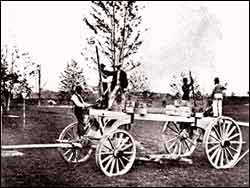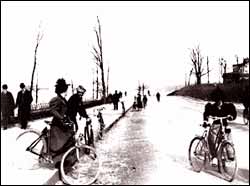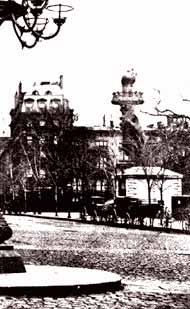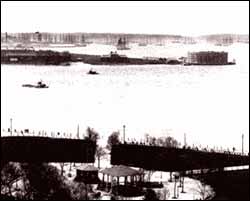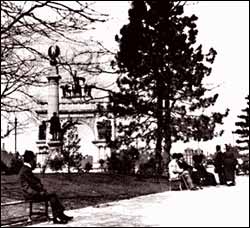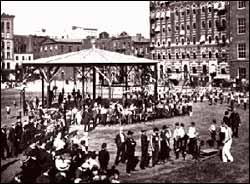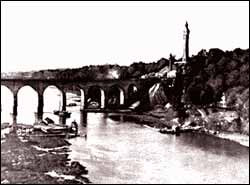Park Planning for Greater New York (1870-1898)
1870
Eighteen-seventy brought drastic change to New York's parks when a group of corrupt politicians, known as the Tweed Ring after William "Boss" Tweed, abruptly replaced the Board of Commissioners of Central Park with a new city agency, the Department of Public Parks. The new park commissioner, Peter B. Sweeny, fired Olmsted, Vaux and Andrew Haswell Green, the park comptroller. Tweed and Sweeny, along with the other key ring members, Mayor A. Oakey Hall and Comptroller Richard B. Connolly seized control of the finances of the city and embezzled hundreds of millions of dollars.
1871
The Tweed Ring was exposed in 1871 and the Department of Public Parks was taken over by some of the former commissioners of Central Park. Andrew Haswell Green was reinstated as Parks Department comptroller, and Olmsted and Vaux were rehired. The new Department of Public Parks completed Central Park and relandscaped many other Manhattan parks in the early 1870s, including Madison Square, Washington Square, Union Square, and Tompkins Square.
1872
The Department of Public Parks acquired a long hilly ridge overlooking the Hudson which became Riverside Park. Frederick Law Olmsted was asked to survey the area in 1873, and he drew up a plan for the park's development that included a curving carriage drive skirting the more difficult terrain and doubling back at the 129th Street vista. In the 1880s walking paths were added to broaden the park's range of uses, but because of the New York Central Railroad's right-of-way, the riverfront remained inaccessible to New Yorkers until the redevelopment of the West Side's shoreline was completed in the 1930s.
1874
Morrisania, West Farms, and Kingsbridge were annexed from Westchester County by New York City in 1874. Other sections of the Bronx were acquired in 1895. An integrated system of parks, roads, sewers and water mains for northern Manhattan and the Bronx was already being planned by the Department of Public Parks.
1875
The first permanent zoo building was constructed behind the Arsenal in Central Park. The Central Park Menagerie, begun with a gift of a bear cub to the board of commissioners in 1858, was officially established and open to the public by 1864, making it the oldest municipal zoo in the country. It had developed somewhat haphazardly, mostly from gifts from the public of all types of animals. In 1873, a census showed 571 animals living in cramped conditions in outdoor pens and in the basement of the Arsenal.
1877
The first wing of the American Museum of Natural History, designed by Calvert Vaux and Jacob Wrey Mould, opened in Manhattan Square (Theodore Roosevelt Park) in 1877. The museum had been organized in 1869 and until 1877 had been housed in the upper floors of the Arsenal in Central Park. After the Museum moved, the Department of Public Parks moved out of its offices in Union Square, and into the Arsenal. Parks Department offices have been in the building ever since, except for one period from 1914 to 1924 when they were installed in the new Municipal Building downtown.
1880
The Metropolitan Museum of Art opened at East 82nd Street in Central Park in 1880 in a modest building designed by Calvert Vaux and Jacob Wrey Mould. When the museum began expanding in every direction, it was decried as an encroachment on Central Park.
1885
Ulysses S. Grant was interred with great ceremony in Riverside Park in a temporary vault designed by Calvert Vaux in 1885. The permanent tomb, designed by John Duncan, was dedicated in 1897 in another elaborate ceremony which included 60,000 marchers and a review of the Navy fleet in the Hudson.
1887
On May 13, 1887, the State Legislature passed the Small Parks Act, a pioneering law that enabled the city to acquire new small parks in crowded neighborhoods. The city did not take advantage of the funds made available by the law until the 1890s, but by 1902 many small parks, including Mulberry Bend (Columbus) Park, Hudson (James J. Walker) Park and De Witt Clinton Park were acquired by the Parks Department through the provisions of the Small Parks Act.
1888
Following the recommendation of a "New Park Commission" set up by the State Legislature five years before, the city took title to St. Mary's, Claremont, Crotona, Bronx, Van Cortlandt, and Pelham Bay parks, as well as Bronx, Pelham, Crotona and Mosholu Parkways: 3,495 acres of the Bronx in all. The cost, assessed on the city at large, was only $9.5 million.
1889
The centennial of Washington's inauguration was celebrated in parks in 1889. A focus of activities was the large plaster arch erected at the base of Fifth Avenue in Washington Square. It was replaced in 1892 by the marble Washington Memorial Arch designed by Stanford White.
1892
The offices of the Brooklyn Parks Department were moved into the Litchfield Villa in Prospect Park, where they remain today. The Villa, an important example of Italianate architecture, was designed by architect Andrew Jackson Davis. Edwin Litchfield, who built the mansion in 1854, donated 24 acres of his estate for Prospect Park after the Civil War. The City of Brooklyn acquired the house in 1869.
1893
The World's Columbian Exposition held in Chicago in 1893 stimulated a revival of neoclassical architecture. In New York this wave of neoclassical and Beaux Arts style resulted in a series of impressive public buildings. It also provoked a sea change in attitudes towards the role of architecture in parks. Monumental architecture had previously been considered out of place in parks, but in the 1890s imposing monuments and buildings began to appear everywhere. Typical examples are the Soldiers and Sailors Memorial Arch in Brooklyn's Grand Army Plaza (1892), Grant's Tomb in Riverside Park (1897), the Prison Ship Martyrs' Monument in Fort Greene Park (1908), and the Battleship Maine Memorial in Central Park (1913).
1895
The City of Brooklyn doubled its total park acreage through acquisitions made by Commissioner Frank Squier. Park sites were chosen along the high ground of the Long Island glacial moraine and financed through Kings County bond sales. Among the so-called "county" parks created were Brooklyn Forest Park (after 1898 Forest Park, Queens), Lincoln Terrace and others, including some of the first seaside city parks: Dyker Beach, Bensonhurst Beach and Canarsie Beach Parks.
Two important firsts in public recreation opened in Brooklyn and the Bronx in 1895. The Prospect Park-Coney Island Bicycle Pathway, which paralleled Olmsted and Vaux's Ocean Parkway, was the first municipal bike path in the United States. In the Bronx, the Van Cortlandt Park Golf Course, the first municipal course in the country, also opened.
1897
Mayor William L. Strong appointed the Small Parks Advisory Committee to advise on acquisition of small parks and playgrounds in the crowded "tenement districts" of Manhattan. Journalist Jacob A. Riis was secretary of the committee which reported that in the original plan of New York "the children seem to have been forgotten." Riis and other progressive reformers urged the creation of new small parks in congested neighborhoods of Hell's Kitchen and the Lower East Side.
1898
Staten Island, Brooklyn and Queens were incorporated with the City of New York in 1898 to form "Greater New York," the world's second largest city (after London) with a population of 3.5 million. At the time of consolidation, Staten Island had fewer than three acres of public parks. Manhattan had nearly 1,300 acres, Brooklyn and Queens together 1,574 (Brooklyn having the lion's share), and the Bronx 4,058 acres. Brooklyn and Queens parks continued to be administered by the Brooklyn park commissioner. The Bronx now had its own commissioner, and the Manhattan commissioner took on responsibility for Staten Island. Together, the three commissioners formed a new board of what was now officially known as the Department of Parks of the City of New York.
